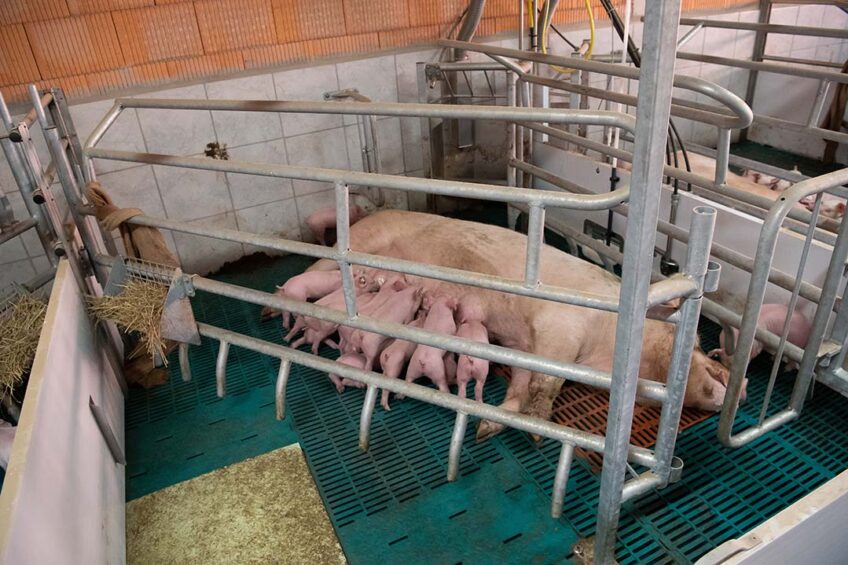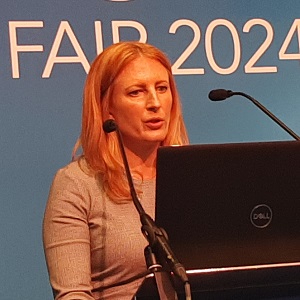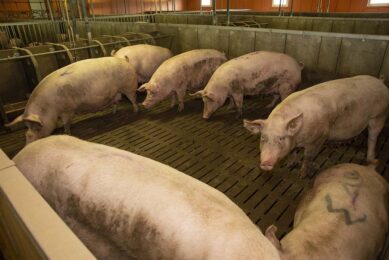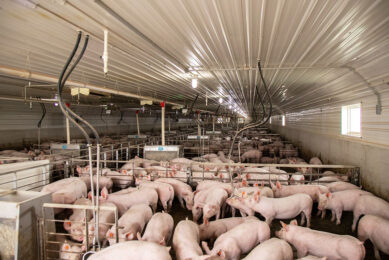Adaptive farrowing: “Extremely costly” for UK producers

Any transition to adaptive farrowing will be extremely costly for producers. It will be vital that they are provided with sufficient financial support from the UK government and the supply chain  and given sufficient time to adapt.
and given sufficient time to adapt.
That was the message of National Pig Association (NPA) chief executive Lizzie Wilson (pictured below) at the British Pig & Poultry Fair, held 15-16 May in Birmingham, United Kingdom. She was commenting following the publication of a report by retired veterinarian and consultant John Mackinnon, which took a detailed look at adaptive farrowing systems currently in place across the UK.
Informing pig industry and policy makers
The aim of Mackinnon’s report was to inform both industry and policy makers on the next steps on adaptive farrowing systems, which provide more space than conventional farrowing crates but allow for sows to be confined in the days around farrowing to protect the new born piglets when they are most vulnerable. Among the report’s key findings is the recommendation that to achieve the ideal balance between sow, piglet and stockperson welfare, the total floor area of adaptive farrowing pens should be between 5.5 and 6.5 m2.
It found that the key benefits of adaptive farrowing systems include high levels of contentment for sows and improved milk yield and piglet weaning weight. But it also uncovered management disadvantages, including piglets being crushed and higher risk of injury to sows and stockpersons.
Independent opinion on adaptive farrowing
The review was commissioned by the NPA to provide an independent opinion on adaptive farrowing systems being used commercially in indoor pig production in the UK as politicians from across the political spectrum consider legislation in this area.
The purpose was to identify where basic design and management features might be adopted confidently by producers considering adaptive farrowing systems in the future, while also complying with regulatory requirements.
Advantages
In total 5 UK commercial indoor pig farms were visited during November and December 2023. Herds ranged from 280 to 3,000 sows totalling 5,910 productive animals, representing 3.5% of the indoor national herd. They contained 1,116 adaptive farrowing pens, about 27% of the total thought to be installed in the UK. Interviews were carried out with farm staff and a standard questionnaire was used to record aspects of physical design, environmental conditions, husbandry and animal management. Stockpersons were asked to give their thoughts on temporary creating compared with permanent crating.
Advantages of temporary crating were:
- An opportunity for sows to lie comfortably in postures of choice once released from temporary crates;
- They show high levels of contentment;
- Socialisation with adjacent neighbours is possible in some systems;
- Sows are calm, quiet and accepting of human presence;
- Feed and water intake is higher;
- Teat exposure for piglets is optimised;
- Milk yield is increased;
- Piglet weaning weights are increased;
- Handling procedures at entry and weaning are facilitated; and
- Sow body condition at weaning is better.
Disadvantages included:
- Gilts need greater attention;
- Gilts and sows sometimes try to get out of temporary crates and may injure themselves and damage structures in the process;
- There is perceived risk of injury to stockpersons when sows are released from temporary crates, requiring greater awareness;
- It can be more difficult to assist farrowing with some cubicle orientations;
- There can be an increase in the number of piglets overlain or crushed, this last point being the major concern.
Pen dimensions and timings
The main areas of contention in relation to adaptive farrowing accommodation include pen dimensions and the duration of confinement of sows, with sow behaviour, piglet welfare and stockperson safety the key considerations, alongside, of course, possible future legislative requirements. With all of these elements considered, the report suggests that the total floor area of the farrowing pen should be between 5.5 and 6.5 m2, with any one side of the free sow space measuring 1.4-1.5 m.
It concluded that more research is needed in a truly commercial setting to determine the pen layout in terms of the ratio of the sow space to the safe space for piglets. All the farms visited in this study have successful farrowing operations with pen dimensions of 6.0-6.2 m2.
The timing of sow confinement within the pens tends to depend on the turnaround time of farrowing pen occupancy. Where it is short, with farrowing occurring a day or 2 after entry, sows are generally confined immediately. Where it is longer, typically up to a week, some consider that sows can remain loose housed until the first in the group farrows, at which point all are confined.
Release 4 days post-farrowing
Experience indicates that release from the crates is successful at around 4 days after farrowing, although gilts should perhaps be released earlier. This means that the total period of confinement varies from around 5 days to around 12 days, depending on management and this appears to work well on commercial farms.
The report was clear, however, that due to the risk of piglet injury in totally free systems, the option for temporary crating is essential.
The report concluded: “Temporary crating offers a real and viable alternative to permanent crating with benefits for sows, piglets and stockpersons, and it also allows for complete sow freedom should this be a management choice. A balance of sow welfare with piglet welfare is necessary.”
However, the report also stresses that it will be costly to install new temporary crating systems because of the increased space required.
“A change from existing permanent crating to temporary crating facilities is most likely to require expansion of existing buildings or the erection of new ones if herd size is to be maintained, but it is clear from the farm visits that investors consider the process worthwhile,” the report concluded.
Wilson said the review would help to “form a wider body of evidence comprising a number of sources of information that we will continue to gather and consider whilst we develop our policy position and government progresses any future legislation.”











